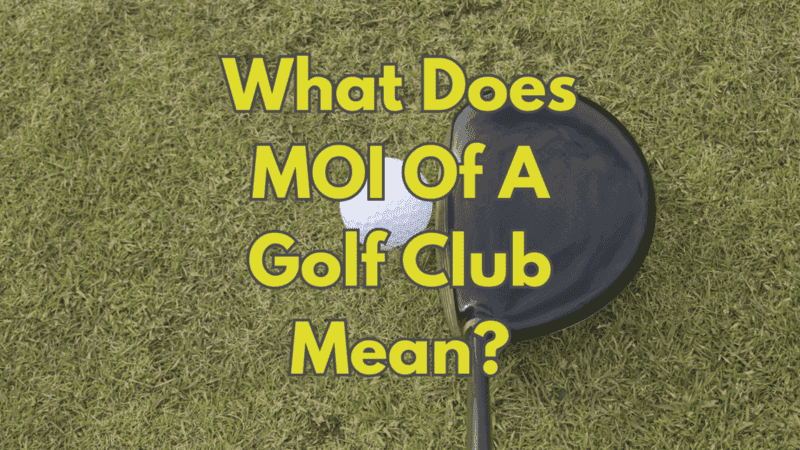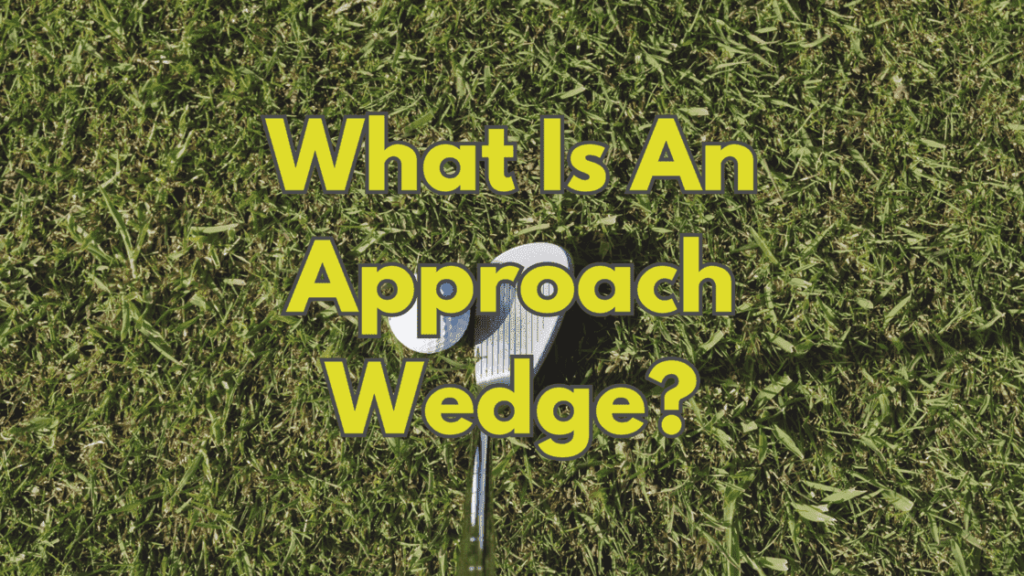The moment of inertia (MOI) is a crucial concept in understanding the performance of golf clubs. It is a measure of an object’s resistance to changes in its rotational motion. But what does MOI of a golf club mean?
In the context of golf clubs, MOI refers to the clubhead’s resistance to twisting upon impact with the golf ball. A higher MOI means the clubhead is less likely to rotate or twist when the ball is struck off-center. This results in better stability and accuracy.
When a golf club has a higher MOI, it minimizes the loss of clubhead speed and energy transfer, providing more consistent and powerful shots. This is particularly important as most amateur golfers tend to mis-hit the ball. Usually by hitting it off-center rather than in the sweet spot. A high MOI can help counter these mis-hits and reduce the loss of distance and accuracy. By understanding and considering the MOI of golf clubs, players can make more informed choices in club selection, leading to improved performance on the course.
The Science behind MOI: How Golf Clubs Work
MOI, or Moment of Inertia, is a crucial concept in understanding how golf clubs work. When it comes to golf club design, MOI refers to the clubhead’s resistance to twisting upon impact with the golf ball. In simpler terms, it measures how stable the clubhead is during the swing.
The higher the MOI value, the more resistant the clubhead is to twisting, resulting in increased stability and reducing the chance of mishits. This stability is particularly important when it comes to off-center hits. A higher MOI helps to maintain clubhead speed and transfer more energy to the ball. This leads to greater distance and accuracy. Through the science behind MOI, golf club manufacturers are able to optimize clubhead design, weight distribution, and materials to enhance performance on the course.
The Role of MOI in Golf Swing Efficiency
The role of MOI in golf swing efficiency is of paramount importance for both amateur and professional golfers alike. MOI, or moment of inertia, refers to the resistance an object has to changes in its rotational motion. In the context of golf clubs, understanding and optimizing MOI can greatly enhance the efficiency and effectiveness of your swing.
When it comes to golf swing efficiency, MOI plays a crucial role in two key aspects: clubhead stability and energy transfer. A high MOI clubhead resists twisting upon impact with the golf ball, providing greater stability and control throughout the swing. This stability allows golfers to maintain their intended swing path and angle of attack, resulting in a more consistent and accurate shot.
Additionally, the MOI affects the transfer of energy from the club to the ball. A higher MOI clubhead can store and release more energy upon impact, resulting in increased ball speed and distance. Conversely, a lower MOI clubhead may lead to decreased energy transfer, resulting in less distance and potential loss of power. By understanding and optimizing the MOI of your golf clubs, you can improve your swing efficiency and ultimately enhance your overall performance on the course.
Key Factors Affecting MOI in Golf Clubs
One of the key factors affecting MOI in golf clubs is the weight distribution. The placement of weight within the clubhead can significantly impact its MOI. Generally, golf club manufacturers try to position the weight towards the perimeter of the clubhead. This increases its resistance to twisting during off-center hits. This redistribution of weight helps in increasing the MOI, making the club more forgiving and providing greater stability during the swing.
Another important factor to consider is the clubhead size. The larger the clubhead, the higher the MOI tends to be. This is because a larger clubhead allows for more weight to be distributed towards the outer edges. Thus increasing its resistance to twisting.
Golfers looking for higher MOI values should consider clubs with larger clubheads, as they provide a greater level of forgiveness and stability, especially on off-center hits. Golf club manufacturers are continuously refining clubhead designs to maximize MOI without sacrificing other aspects of performance such as aerodynamics and ball speed.
MOI and Clubhead Stability: Why it Matters
Golf club manufacturers constantly strive to improve clubhead stability, and the concept of Moment of Inertia (MOI) plays a crucial role in achieving this goal. MOI refers to the club’s resistance to twisting when it makes contact with the golf ball. This property is especially important because any amount of twisting can significantly affect the accuracy and consistency of your shots. By increasing the MOI of the clubhead, manufacturers aim to minimize the clubhead’s tendency to twist, allowing for a more stable and controlled swing.
When the clubhead remains stable throughout the swing, it enables golfers to achieve a more consistent impact position on the ball. This consistency leads to greater accuracy and control over shot direction. With a higher MOI, the clubhead is less likely to twist off line, ensuring that the face remains square to the target at impact.
As a result, golfers can achieve more predictable and reliable shots, regardless of their swing speed or skill level. MOI’s influence on clubhead stability is therefore a vital aspect in golf club design, allowing players to gain confidence and improve their overall performance on the course.
The Relationship between MOI and Forgiveness in Golf Clubs
Forgiveness is a crucial aspect of any golf club design, as it directly impacts the overall performance and accuracy of a golfer’s shots. In this regard, the relationship between the Moment of Inertia (MOI) and forgiveness in golf clubs becomes of utmost significance. MOI refers to the club’s resistance to twisting when it makes contact with the golf ball. A higher MOI values contribute to increased forgiveness.
By increasing the MOI in golf club designs, manufacturers aim to minimize the effects of off-center hits. This results in better accuracy and consistency in shot outcomes. Golfers can benefit from clubs with higher MOI values, as they offer an increased margin for error, allowing for more playable shots and better overall performance on the course.
The relationship between MOI and forgiveness in golf clubs extends beyond mere shot accuracy. It also encompasses the ability of the club to provide a satisfying feel and feedback to the golfer. When a club has a higher MOI, it becomes more stable through impact, reducing vibrations and ensuring a smoother, more controlled swing.
This enhanced stability leads to improved shot consistency and increased confidence. This is because golfers can trust that the club will perform consistently even on mishits. The forgiveness provided by higher MOI values not only helps golfers achieve better results but also fosters a positive and enjoyable experience on the course. This promotes greater satisfaction and a more enjoyable game overall.
Analyzing MOI Values in Golf Club Design
Understanding the various factors that influence the moment of inertia (MOI) values in golf club design is essential for golfers and club manufacturers alike. When analyzing MOI values in golf club design, several key elements come into play. One of these is the distribution of weight within the clubhead, which greatly affects the MOI. By strategically placing weight at different locations, designers can manipulate the MOI to optimize club performance.
Additionally, the shape and size of the clubhead also play a crucial role in determining the MOI value. A larger clubhead with a wider profile typically results in a higher MOI, providing increased stability and forgiveness on off-center hits.
Conversely, a smaller clubhead with a more compact shape may have a lower MOI. Which offers greater control and workability for skilled players looking to shape their shots. By analyzing the MOI values along with other design aspects, golf club manufacturers can tailor their designs to meet the specific needs and preferences of different golfers, ultimately enhancing their overall performance on the course.
MOI and Distance Control: Finding the Sweet Spot
Finding the sweet spot in distance control is a crucial aspect of golf. The moment of inertia (MOI) of a golf club plays a significant role in achieving this precision. MOI refers to the club’s resistance to twisting when you make a swing. Higher MOI values in the clubhead can aid in creating a more stable and controlled swing, resulting in better distance control.
When the MOI of a golf club is optimized, it improves the golfer’s ability to find the sweet spot consistently. The sweet spot is the center of the clubface that yields maximum distance and accuracy. By maximizing the MOI, golfers can reduce the clubhead’s tendency to rotate or twist upon impact, therefore increasing the likelihood of striking the ball with the sweet spot. This enhanced stability contributes to more consistent shots and improved distance control on the golf course.
MOI and Shot Dispersion: Improving Accuracy on the Course
The moment of inertia (MOI) in golf clubs plays a critical role in improving accuracy on the course. When it comes to shot dispersion, having a higher MOI can greatly benefit golfers. The MOI of a golf club determines how resistant it is to twisting upon impact. A higher MOI means that the clubhead is less likely to rotate or twist, resulting in a more stable and consistent shot.
By incorporating a higher MOI into club design, manufacturers aim to reduce the effects of off-center hits. When a shot is struck away from the center of the clubface, the MOI helps to maintain the clubhead’s stability and minimize the amount of directional and distance loss.
This leads to improved accuracy as the ball is more likely to fly straight and predictably. This is true even with slightly mishit shots. Golfers can therefore have more confidence in their swings, knowing that their clubs are designed to reduce shot dispersion and enhance accuracy on the course.
Enhancing Performance: How MOI Can Benefit Your Golf Game
The moment of inertia (MOI) is a fundamental concept in golf club design that can have a significant impact on your performance on the course. By understanding and optimizing the MOI of your golf clubs, you can enhance your overall game and achieve better results.
One key benefit of optimizing the MOI is improved forgiveness. When a golf club has a higher MOI, it becomes more resistant to twisting upon impact with the ball. This means that even if your swing is not perfect, the club will be more forgiving and provide better results.
With a higher MOI, off-center hits will still have a higher chance of achieving reasonable distance and accuracy. Making sure that you can stay in play and avoid costly mistakes. This forgiveness factor can be particularly beneficial for amateur and recreational golfers who may not have the consistency and precision of professional players.
FAQs
What does MOI stand for in golf?
MOI stands for Moment of Inertia in golf.
What is the Moment of Inertia (MOI) in golf clubs?
The Moment of Inertia (MOI) is a measurement of a club’s resistance to twisting when struck by a golfer.
How does MOI affect a golf club’s performance?
MOI affects a golf club’s performance by influencing its stability, forgiveness, distance control, shot dispersion, and overall efficiency in the golf swing.
What factors affect the MOI of a golf club?
Factors that affect the MOI of a golf club include the club’s weight distribution, design, and the placement of its center of gravity.
Why is clubhead stability important in golf?
Clubhead stability is important in golf because it helps golfers achieve consistent ball striking and accuracy by minimizing the effects of off-center hits.
What is the relationship between MOI and forgiveness in golf clubs?
Higher MOI values in golf clubs typically lead to increased forgiveness, meaning they are more forgiving of mishits and provide a larger sweet spot for better results on off-center strikes.
How do MOI values impact distance control in golf clubs?
MOI values can influence distance control by promoting a more consistent transfer of energy from the club to the ball, resulting in improved control over the distance the ball travels.
How does MOI affect shot dispersion on the golf course?
Golf clubs with higher MOI values tend to have reduced shot dispersion, meaning they help golfers achieve greater accuracy and tighter shot patterns on the course.
How can MOI benefit my golf game?
Understanding and utilizing MOI can benefit your golf game by improving your consistency, accuracy, forgiveness, distance control, and overall performance on the course.




